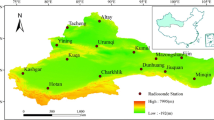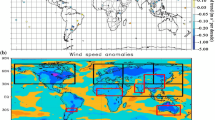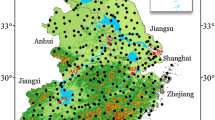Abstract
We investigate the multi-decadal variability of observed surface wind speed around South Korea. It is found that surface wind speed exhibits decreasing trend from mid-1950s until 2003, which is similar with the trends reported for other parts of the world. However, the decreasing trend ceases and becomes unclear since then. It is revealed that decreasing wind speed until 2003 is strongly associated with the decreasing trend of the spatial variance in both atmospheric pressure and air temperature across the East Asia for the same period. On the contrary, break of decreasing trend in surface wind speed since 2003 is associated with increasing spatial variance in surface temperature over the East Asia. Ground observation shows that surface wind speed and air temperature exhibit highly negative correlations for both summer and winter prior to 2003. However, since 2003, the correlations differ between seasons. We suggest that mechanisms behind the recent wind speed trend are different between summer and winter. This is on the basis of an interesting finding that air temperature has decreased while surface temperature has increased during winter months since 2003. We hypothesize that such contrasting temperature trends indicate more frequent movement of external cold air mass into the region since 2003. We also hypothesize that increasing summer wind speed is driven by intrusion of warm air mass into the region which is witnessed via increasing spatial variance in surface temperature across East Asia and the fact that both air and surface temperature rise together.









Similar content being viewed by others
References
Ao CO, Hajj AJ (2013) Monitoring the width of the tropical belt with GPS radio occultation measurements. Geophys Res Lett 40:6236–6241. doi:10.1002/2013GL058203
Azorin-Molina C, Vicente-Serrano SM, McVicar TR, Jerez S, Sanchez-Lorenzo A, López-Moreno JI et al (2014) Homogenization and assessment of observed near-surface wind speed trends over Spain and Portugal, 1961–2011. J Clim 27(10):3692–3712. doi:10.1175/JCLI-D-13-00652.1
Bazeos N, Hatzigeorgiou GD, Hondros ID, Karamaneas H, Karabalis DL, Beskos DE (2002) Static, seismic and stability analyses of a prototype wind turbine steel tower. Eng Struct 24(8):1015–1025
Birner T (2010) Recent widening of the tropical belt from global tropopause statistics: sensitivities. J Geophys Res 115:D23109. doi:10.1029/2010JD014664
Bormann H (2011) Sensitivity analysis of 18 different potential evapotranspiration models to observed climatic change at German climate stations. Clim Change 104(3–4):729–753
Bornstein RD, Johnson DS (1977) Urban–rural wind velocity differences. Atmos Environ 11(7):597–604
Brazdil R, Chroma K, Dobrovolny P, Tolasz R (2009) Climate fluctuations in the Czech Republic during the period 1961–2005. Int J Climatol 29(2):223–242
Brunke MA, Wang Z, Zeng X, Bosilovich M, Shie C (2011) An assessment of the uncertainties in ocean surface turbulent fluxes in 11 reanalysis, satellite-derived, and combined global datasets. J Clim 24(21):5469–5493
Burton T, Sharpe D, Jenkins N, Bossanyi E (2001) Wind energy handbook. Wiley, New York
Dunne T, Leopold LB (1978) Water in environmental planning. WH Freeman and Co., San Fransisco
Elsner JB, Jagger T, Niu XF (2000) Changes in the rates of North Atlantic major hurricane activity during the 20th century. Geophys Res Lett 27(12):1743–1746. doi:10.1029/2000GL011453
Frost R (1948) Atmospheric turbulence. Q J R Meteorol Soc 74(321–322):316–338
Fu G, Yu J, Zhang Y, Hu S, Ouyang R, Liu W (2011) Temporal variation of wind speed in China for 1961–2007. Theor Appl Climatol 104(3–4):313–324
Gong DY, Wang SW, Zhu JH (2001) East Asian winter monsoon and Arctic oscillation. Geophys Res Lett 28(10):2073–2076
Griffin BJ, Kohfeld KE, Cooper AB, Boenisch G (2010) Importance of location for describing typical and extreme wind speed behavior. Geophys Res Lett 37:L22804. doi:10.1029/2010GL045052
Gsanger S, Pitteloud J (2012) World wind energy report 2011. World Wind Energy Association, Bonn
Guo H, Xu M, Hu Q (2010) Changes in near-surface wind speed in China: 1969–2005. Int J Climatol 31(3):349–358
Haltiner GJ, Martin LF (1957) Dynamical and physical meteorology. McGraw-Hill Book Company, New York
Holton JR, Hakim GJ (2013) An introduction to dynamic meteorology. Academic press, London
Hsu SA, Meindl EA, Gilhousen DB (1994) Determining the power-law wind-profile exponent under near-neutral stability conditions at sea. J Appl Meteorol Climatol 33(6):757–765
Keyhani A, Ghasemi-Varnamkhasti M, Khanali M, Abbaszadeh R (2010) An assessment of wind energy potential as a power generation source in the capital of Iran, Tehran. Energy 35(1):188–201
Kim J, Kim D (2013) Spatio-temporal characteristics of wind observations over South Korea: 1982–2011. Asia Pac J Atmos Sci 49(4):551–560
Kohler MA (1959) Lake and pan evaporation water-loss investigation, vol I. Lake Hefner studies. US Geological Survey Technical Report
Köhler H (1933) Meteorologische Turbulenzuntersuchungen. Kungl. svenska Vetenskapsakad. Handl., 13
Kumar SP, Roshin RP, Narvekar J, Kumar PK, Vivekanandan E (2009) Response of the Arabian Sea to global warming and associated regional climate shift. Mar Environ Res 68(5):217–222
Lucas C, Timbal B, Nguyen H (2014) The expanding tropics: a critical assessment of the observational and modeling studies. WIREs Clim Change 5(1):89–112. doi:10.1002/wcc.251
McVicar TR, Van Niel TG, Li LT, Roderick ML, Rayner DP, Ricciardulli L et al (2008) Wind speed climatology and trends for Australia, 1975–2006: capturing the stilling phenomenon and comparison with near-surface reanalysis output. Geophys Res Lett 35(20):L20403. doi:10.1029/2008GL035627
McVicar TR, Roderick ML, Donohue RJ, Li LT, Van Niel TG, Thomas A et al (2012) Global review and synthesis of trends in observed terrestrial near-surface wind speeds: implications for evaporation. J Hydrol 416:182–205
Merchant CJ, Embury O, Rayner NA, Berry DI, Corlett GK, Lean K et al (2012) A 20 year independent record of sea surface temperature for climate from Along-Track scanning radiometers. J Geophys Res 117:C12013. doi:10.1029/2012JC008400
Montgomery DC (2009) Introduction to statistical quality control, 6th edn. Wiley, New York
Najac J, Boé J, Terray L (2009) A multi-model ensemble approach for assessment of climate change impact on surface winds in France. Clim Dyn 32(5):615–634
Nguyen H, Evans A, Lucas C, Smith I, Timbal B (2013) The Hadley circulation in reanalyses: climatology, variability, and change. J Clim 26(10):3357–3376
Oke TR (2004) Initial guidance to obtain representative meteorological observations at urban sites, vol 81. World Meteorological Organization, Geneva
Parker D, Folland C, Scaife A, Knight J, Colman A, Baines P, Dong B (2007) Decadal to multidecadal variability and the climate change background. J Geophys Res 112:D18115. doi:10.1029/2007JD008411
Penman HL (1948) Natural evaporation from open water, bare soil and grass. Proc R Soc Lond Math Phys Sci 193(1032):120–145
Peterson EW, Hennessey JP (1978) On the use of power laws for estimates of wind power potential. J Appl Meteorol Climatol 17(3):390–394
Pryor SC, Ledolter J (2010) Addendum to “Wind speed trends over the contiguous United States”. J Geophys Res 115:D10103. doi:10.1029/2009JD013281
Roderick ML, Rotstayn LD, Farquhar GD, Hobbins MT (2007) On the attribution of changing pan evaporation. Geophys Res Lett 34:L17403. doi:10.1029/2007GL031166
Rossby C-G (1932) Thermodynamics applied to air mass analysis. MIT Meteorol Pap 1(3):1–41
Ryoo S-B, Kim Y-H, Kwon T-H, Park I-S (2006) Inhomogeneities in Korean climate data (I): due to site relocation. Atmosphere 16(3):215–223
Smits A, Klein Tank AMG, Konnen GP (2005) Trends in storminess over the Nethelands, 1962–2002. Int J Climatol 25(10):1331–1344
Spearman C (1904) The proof and measurement of association between two things. Am J Psychol 15(1):72–101
Tamura Y, Suda K (1989) Correction of annual maximum wind speed considering yearly variation of the ground roughness in Japan. J Wind Eng Ind Aerodyn 32(1–2):21–30
Taylor WA (2000) Change-point analysis: a powerful new tool for detecting changes. http://www.variation.com/cpa/tech/changepoint.html
Tuller SE (2004) Measured wind speed trends on the west coast of Canada. Int J Climatol 24(11):1359–1374
Uppala SM, Kållberg PW, Simmons AJ, Andrae U, Bechtold V et al (2005) The ERA-40 re-analysis. Q J R Meteorol Soc 131(612):2961–3012
Vautard R, Cattiaux J, Yiou P, Thépaut JN, Ciais P (2010) Northern Hemisphere atmospheric stilling partly attributed to an increase in surface roughness. Nat Geosci 3(11):756–761
Wan H, Wang XL, Swail VR (2010) Homogenization and trend analysis of Canadian near-surface wind speeds. J Clim 23(5):1209–1225
Xu M, Chang CP, Fu C, Qi Y, Robock A, Robinson D et al (2006) Steady decline of East Asian monsoon winds, 1969–2000: evidence from direct ground measurements of wind speed. J Geophys Res 111:D24111. doi:10.1029/2006JD007337
You Q, Kang S, Flügel W, Pepin N, Yan Y, Huang J (2010) Decreasing wind speed and weakening latitudinal surface pressure gradients in the Tibetan plateau. Clim Res 42(1):57–64
Acknowledgments
This research was supported by the Basic Science Research Program through the National Research Foundation of Korea (NRF) funded by the Ministry of Science, ICT and Future Planning (Grant Number 2012R1A2A2A01015355). Ground-observed dataset used in this study are from the website of the Korean Meteorological Administration (http://www.kma.go.kr/weather/climate/past_cal.jsp). MODIS data is from the website: http://neo.sci.gsfc.nasa.gov/ and we retrieved ERA-40 products from the website of the Asia-Pacific data-research center of the International Pacific Research Center (http://apdrc.soest.hawaii.edu/). We thank the editor and anonymous reviewers for their constructive comments.
Author information
Authors and Affiliations
Corresponding author
Appendices
Appendix 1: Transition point
To determine the transition point in the time series, yearly difference time series are first obtained from annual mean and annual maximum series, respectively. Then, transition points are calculated from the yearly difference time series. We implemented three methods of two-phase regression technique (Elsner et al. 2000), tabular cumulative summation test (Montgomery 2009), and commercial program based on combination of cumulative summation charts and bootstrapping (Taylor 2000). These methods yield different transition points (Table 2). Here, we follow the result from Elsner et al. (2000)’s method in that this method gives the same year (2003) as the transition point for both annual mean and annual maximum series.
When we implement the same methods with the original annual mean and annual maximum series and transition points are less clearly identified. Using yearly difference time series enhances clarity in determining transition points.
Appendix 2: Statistical significance of trends
All trends reported in this paper, i.e., not only those of wind speed but also of geopotential and temperature, are tested for statistical significance. The significance of linear regression trends is tested within 95 and 90 % confidence levels by student’s t test using Spearman’s rank correlation (1904). Most trends prior to 2003 are found statistically significant at 90 % confidence level (Table 3). Not all trends are found significant and we distinguish statistically significant trend and the rest by using solid or dashed line in all linear regression lines.
Rights and permissions
About this article
Cite this article
Kim, J., Paik, K. Recent recovery of surface wind speed after decadal decrease: a focus on South Korea. Clim Dyn 45, 1699–1712 (2015). https://doi.org/10.1007/s00382-015-2546-9
Received:
Accepted:
Published:
Issue Date:
DOI: https://doi.org/10.1007/s00382-015-2546-9




